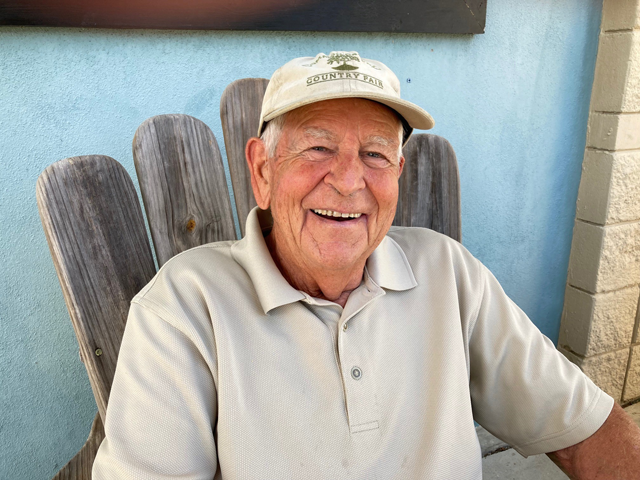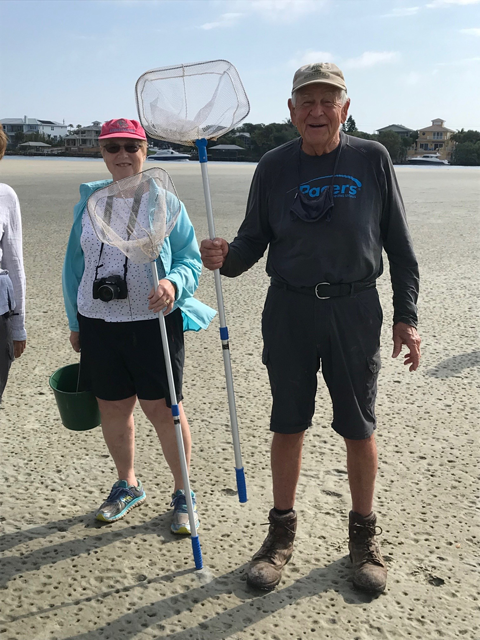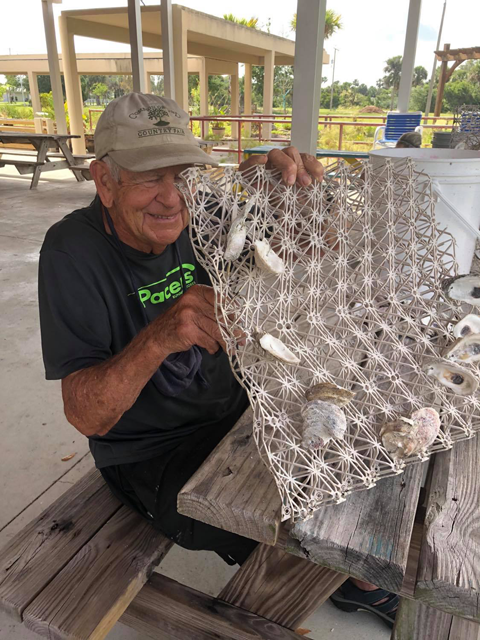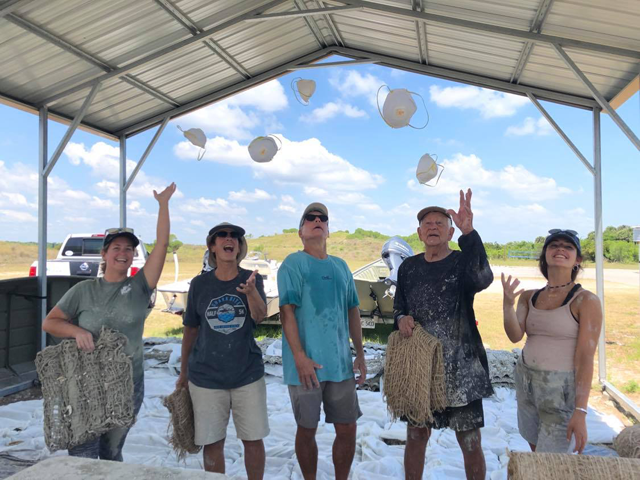The first thing you will notice about Marine Discovery Center volunteer Dick Clement is the sparkle in his eye, the spring in his step and the ageless energy of this smiling octogenarian.
The 6-foot-1 New Englander moved to Port Orange, Fla., last December and quickly rolled up his sleeves and got his feet wet in shoreline restoration projects, gladly lifting 35-pound bags of oyster shells and slogging along with fellow MDC volunteers to strategically install oysters, cord grass and mangrove trees.
Read more about Dick in MDC’s October 2021 Volunteer Spotlight interview with staff writer Lisa D. Mickey:
Q: Where did you grow up?
A: I grew up in Worcester, Mass.
Q: Where did you go to school?
A: I graduated from the University of Massachusetts with a civil engineering degree.
Q: What did you do in your career?
A: My first job was with the U.S. Forest Service in the White Mountains of New Hampshire. Those mountains are dear to me! And then I went into the U.S. Navy and did a variety of things after that. Before moving to Florida last December, I worked for five years on an organic vegetable farm in northern Virginia. That was a top experience in my life.
Q: Why?
A: I love physical work and I wanted to do something connected with the environment. Organic vegetable farming sounded just right. I found a farm six miles from my home in Virginia. It was started by a Chinese woman who is now a year older than I am and her daughter is the farm manager. There were many days as I was leaving the farm at 3 p.m., that I would pause and say to myself, “I love this farm, the people on it and I love what I’m doing.”
Q: Doing the work of a civil engineer is very different than working on an organic vegetable farm.
A: You think of farming as hoeing, raking, weeding, picking and planting, but I soon worked my way into the construction end of things. Building trellises for tomatoes was a very important part of growing cherry tomatoes. You have a six-foot post with wire and you have to tie the tomato plants up to the top with a special wire tie that won’t choke the plant. I also had to fence off plots of vegetables and handle irrigation there. We grew all kinds of vegetables. And in the fall, we had fresh-pressed cider. We had a cider-press operation, in which I participated.
Q: Was the farm a CSA (Community-Supported Agriculture) site?
A: They had over 500 subscribers annually, but when the pandemic hit, it jumped to 700. So, they had a continual need to grow the vegetables and get them down to the farm stand, where I helped sell the vegetables. We were at five different markets.
Q: What kind of things did you build in your career as a civil engineer?
A: In the Forest Service up in the White Mountains, the forest engineer had me design and participate in the construction of two bridges on the Tuckerman Ravine Trail on Mount Washington. These were big treated timber bridges that supported snow cats [a large trail grooming vehicle that prepares ski trails]. I got to design and help make a foot suspension bridge across the east branch of the Pemigewasse River in a famous wilderness area of the White Mountains where there are rounded rocks and rushing water. Those were special civil engineering projects I did while I was there for two years.
Q: Where did you go from the White Mountains?
A: That’s when I went into the Navy. It was after the Korean War and before the war in Vietnam. I wanted to serve in the military, so I volunteered for OCS [Officer Candidate School] in Newport, R.I., and spent a good part of my four-year military career on Guam in the Mariana Islands. I was the only civil engineer officer at the Naval supply depot. My job there was to dismantle hangar bases at Harmon Field, which was a base for B-29 bombers in World War II. After I dismantled them, I had to transport steel in usable condition to ship repair facilities. The supply depot captain wanted me to design and build a lumber shed on the waterfront out of this steel, but I had to find my own supplies and a way to get it built because there was no budget for me. Here I was, a young Ensign in my early 20s in charge of land transportation service and I had to figure out how to get it done, which I did.
Q: What did you do after the Navy?
A: I went out to Denver and worked in a real estate management company for a few years and then I went to work for Red Owl [grocery] stores in Hopkins, Minn. I was a real estate negotiator for them and would find sites for their stores throughout the upper Midwest. I was with them for about four years before moving to northern Virginia, where I worked in home building, land development and soil testing for drain fields. Later, I worked for about 10 years in a running store. But I came home one night and told my wife Lyn that I’d had an epiphany – I wanted to work on an organic farm or with something to do with the ocean. So, that’s when I signed up for the vegetable farm. I’d still be there except we sold our home and moved down here near our son in Daytona Beach.
Q: How did you start volunteering at MDC?
A: To be honest, volunteering was not on my mind when I came here last December. I started volunteering at MDC in February this year, but it began up at Gamble Rogers State Park. I had read one of their newsletters and got involved in their shoreline stabilization and mangrove planting projects. It was a terrific group of volunteers, researchers and graduate students from UCF. Some MDC people were in that group and mentioned that they had similar volunteer opportunities available there that would be closer to me.
Q: You and your wife Lyn also took our Coastal class in February through the Florida Master Naturalist Program.
A: We enjoyed that class so much and we both enjoy all that’s involved in shoreline stabilization. That course was so important. The more you learn, the more you realize how much you don’t know. I remember looking at water from the lagoon under a microscope at MDC. That’s where I realized that water isn’t just water! It’s a living thing! And then when we were out seining in the Coastal class and opened up that first net, there were all kinds of fish, crabs and living things in that net. What’s in this water? Everything! More than I ever imagined!
Q: Working in shoreline restoration and with the oyster program can be hard work with some heavy lifting. Do you enjoy that?
A: It’s in my DNA to enjoy hard work. From an engineering standpoint and from my interest in environmental things and nature, wow, I wouldn’t want to be any other place than where I was in that water, working hard and feeling fulfilled when I headed home!
Q: What kind of volunteer work are you doing now?
A: Lyn and I both are working in the Shuck & Share oyster program and with shoreline restoration at MDC. We have also signed up to help with the sea turtle washback program. We check the wrack line for sea turtles that have been washed in by storms.
Q: Did you grow up being outdoors a lot with your family as a boy?
A: I always had an interest in outdoor sports. In high school, I worked for the Appalachian Mountain Club. When I was 16, I worked a summer job at Pinkham Notch in New Hampshire [a mountain pass in New Hampshire’s White Mountains]. I worked with another fellow from Maine and our assignment in June was to distribute the initial supply loads to the eight remote huts located throughout the White Mountains using donkeys. We were delivering tin cans of food and propane tanks to the sites and you can only get to them by hiking. We would set up our tent camps at a trail head with a sapling fence for six donkeys. The two of us would work three days for each of the huts. We’d load up the saddle bags at the trail head, head up to the hut and distribute the supplies, then come back down to our camp, treat the saddle sores on the donkeys, prepare our own dinner, go to sleep and start again the next morning.
Q: Weren’t you an athlete at the University of Massachusetts?
A: I played football as a freshman and I was on the downhill racing ski team. At one of the first events with the ski team, the coach needed an extra ski jumper. He asked if I would give it a try. We had a 30-meter hill and there was an entry for it halfway up. He told me to put on some long, grooved skis and to just give it a try and ride it out. I went off the end and the whole world disappeared from under me. I landed on my feet, didn’t fall, but it wasn’t pretty. It was more like a helicopter trip. I had fun with football in high school, but I wasn’t great at it in college.
Q: You must have been a runner if you worked in a running store.
A: Yes, I used to run a lot. I ran three marathons – the New York City Marathon and two Marine Corps Marathons. I also did triathlons. I enjoy the sport of running, so when I worked in the running store, I could really help people if they needed attention for shoes. I liked connecting with customers.
Q: What kind of hobbies do you have now?
A: Watercolor painting. I paint various things I’m interested in, such as sea birds, grasses and dunes. I’ve done a series of flower and plant cards. We also have an RV. We took it all the way up to Maine, where Lyn’s family has a place on a lake.
Q: When did you and Lyn get married?
A: We were married 40 years ago. She grew up in Connecticut and New Jersey. We have one son and I have two children from a former marriage. We also have four grandchildren.
Q: What do you enjoy about volunteering?
A: What makes it fun for me is doing something that has so much meaning. When you spend the day on Canaveral National Seashore working with people who are energetic and dedicated to creating oyster beds and environments for other marine life, that’s pretty special. It’s rewarding to see mangrove trees and cord grass planted behind the protective barrier of oysters in shoreline stabilization projects.
Q: Why do you want to volunteer?
A: I want to volunteer because I want to stay in that frame of mind of learning and bonding with people and doing something I enjoy. It’s very important to me to keep myself in shape to be able to do those kinds of things.
Q: What excites you the most about being involved in MDC’s conservation mission in our coastal ecosystem?
A: Realizing I can play a role in the whole idea of protecting the lagoon, and being able to talk to my neighbors about it. There’s just pure enjoyment in doing the shoreline restoration projects and riding back on the boat to the starting point with the other volunteers. You feel like you’ve really done something worthwhile.
Q: Has there been a highlight for you as an MDC volunteer?
A: The Florida Master Naturalist course was a highlight, but meeting here at 6:30 in the morning and going down to Canaveral and doing that physical work with an awesome group of people has been the highlight. I took samples of oyster shells with me to Maine to show people and talk about what we’re doing here. People listened to me.
Q: How do you think our programs at MDC benefit from your skill set?
A: Attitude. I bring my interest in nature and experience with the Forest Service. I’m interested in the natural world and willing to learn more about it while learning how to participate in ways to protect it.
Q: You’re going to celebrate your 85th birthday this fall. How do you maintain that spark to keep going?
A: I meet people and learn about things that I want to be a part of. I don’t want to let opportunities pass me by. I keep motivated to walk, swim and do exercise. When I applied for work at the vegetable farm, the woman who does the hiring told me they weren’t used to getting applications from someone of my demographic. She asked why I was interested? I told her it’s about learning, teamwork and being interested in what I’m doing. That applies here, too. There’s a real camaraderie with the other volunteers and socializing is a big part of it. I’m grateful to MDC and Gamble Rogers State Park for offering these restoration programs. It was an immediate connection with good timing. Within the first two months of moving down here, we got involved. So, being involved is what keeps me going.






Follow Us!